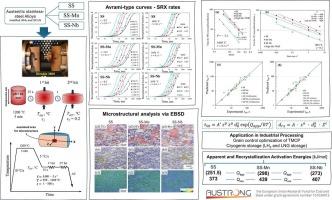Static recrystallization characteristics and kinetics of austenitic stainless steels under development for LH2 storage applications
IF 7.9
2区 材料科学
Q1 MATERIALS SCIENCE, MULTIDISCIPLINARY
引用次数: 0
Abstract
Developing high-strength austenitic stainless steel (ASS) grades for lightweight cryogenic storage tanks, particularly for liquefied hydrogen (LH2), demands precise microstructure control achievable via optimized thermomechanically controlled processing (TMCP). In recrystallization–controlled regime of TMCP, successive rolling passes facilitate microstructural refinement through dynamic and static restoration mechanisms. This work illustrates static recrystallization (SRX) characteristics and kinetics in three ASS alloys designed by varying N, Mn and Nb contents. Interrupted (double–hit) compression tests were conducted to characterize the flow behaviour and microstructural evolution across different deformation conditions. SRX kinetics were formulated using a fractional–softening framework, where the time to 50 % recrystallization was correlated with strain, strain rate, temperature, and initial grain size. While the exponents of strain (−3.1) and strain rate (−0.3) were consistent across all compositions, the apparent activation energies of SRX varied in the range 251.5–298 kJ·mol−1, with 7 wt% Mn showing a more noticeable effect in comparison with 0.1 wt% Nb. Detailed metallographic analysis confirmed the accuracy of the derived models. Suitable semi-empirical relations were established enabling prediction of statically recrystallised grain size across various processing conditions. These results define the processing windows needed to design TMCP schedules for advanced ASSs for LH2 and cryogenic environments.

用于LH2储存的奥氏体不锈钢的静态再结晶特性和动力学研究
开发用于轻质低温储罐(特别是液化氢储罐)的高强度奥氏体不锈钢(ASS)牌号,需要通过优化的热机械控制加工(TMCP)来实现精确的微观结构控制。在TMCP再结晶控制下,连续轧制通过动态和静态恢复机制促进组织细化。本文阐述了三种不同N、Mn和Nb含量的ASS合金的静态再结晶(SRX)特性和动力学。进行了中断(双击)压缩试验,以表征不同变形条件下的流动行为和微观组织演变。SRX动力学采用分数-软化框架,其中到50%再结晶的时间与应变、应变速率、温度和初始晶粒尺寸相关。所有成分的应变指数(−3.1)和应变率指数(−0.3)一致,SRX的表观活化能在251.5 ~ 298 kJ·mol−1范围内变化,其中7 wt% Mn比0.1 wt% Nb的影响更明显。详细的金相分析证实了所得模型的准确性。建立了适合的半经验关系,可以预测不同工艺条件下的静态再结晶晶粒尺寸。这些结果定义了设计LH2和低温环境下先进ass的TMCP时间表所需的处理窗口。
本文章由计算机程序翻译,如有差异,请以英文原文为准。
求助全文
约1分钟内获得全文
求助全文
来源期刊

Materials & Design
Engineering-Mechanical Engineering
CiteScore
14.30
自引率
7.10%
发文量
1028
审稿时长
85 days
期刊介绍:
Materials and Design is a multi-disciplinary journal that publishes original research reports, review articles, and express communications. The journal focuses on studying the structure and properties of inorganic and organic materials, advancements in synthesis, processing, characterization, and testing, the design of materials and engineering systems, and their applications in technology. It aims to bring together various aspects of materials science, engineering, physics, and chemistry.
The journal explores themes ranging from materials to design and aims to reveal the connections between natural and artificial materials, as well as experiment and modeling. Manuscripts submitted to Materials and Design should contain elements of discovery and surprise, as they often contribute new insights into the architecture and function of matter.
 求助内容:
求助内容: 应助结果提醒方式:
应助结果提醒方式:


